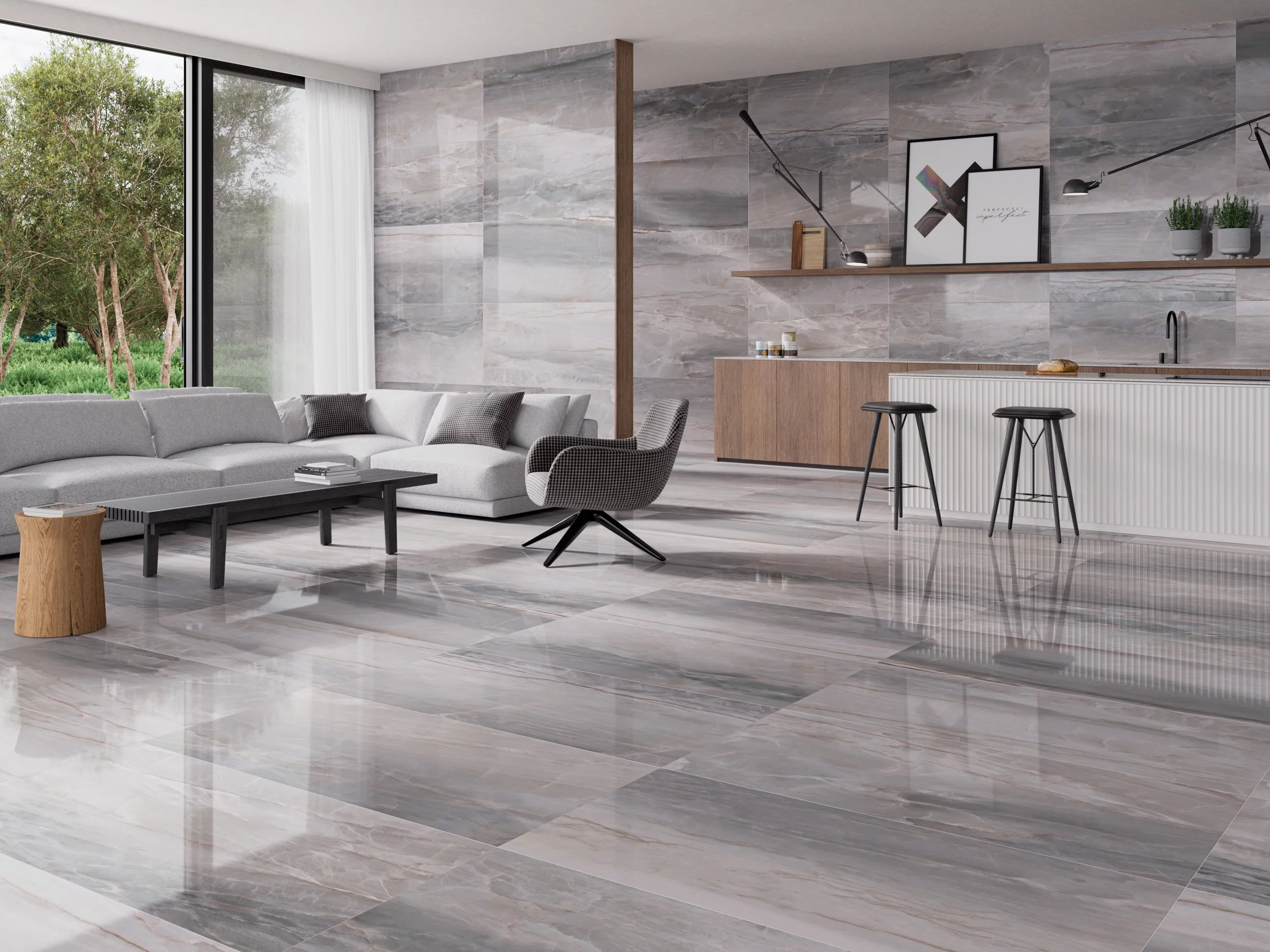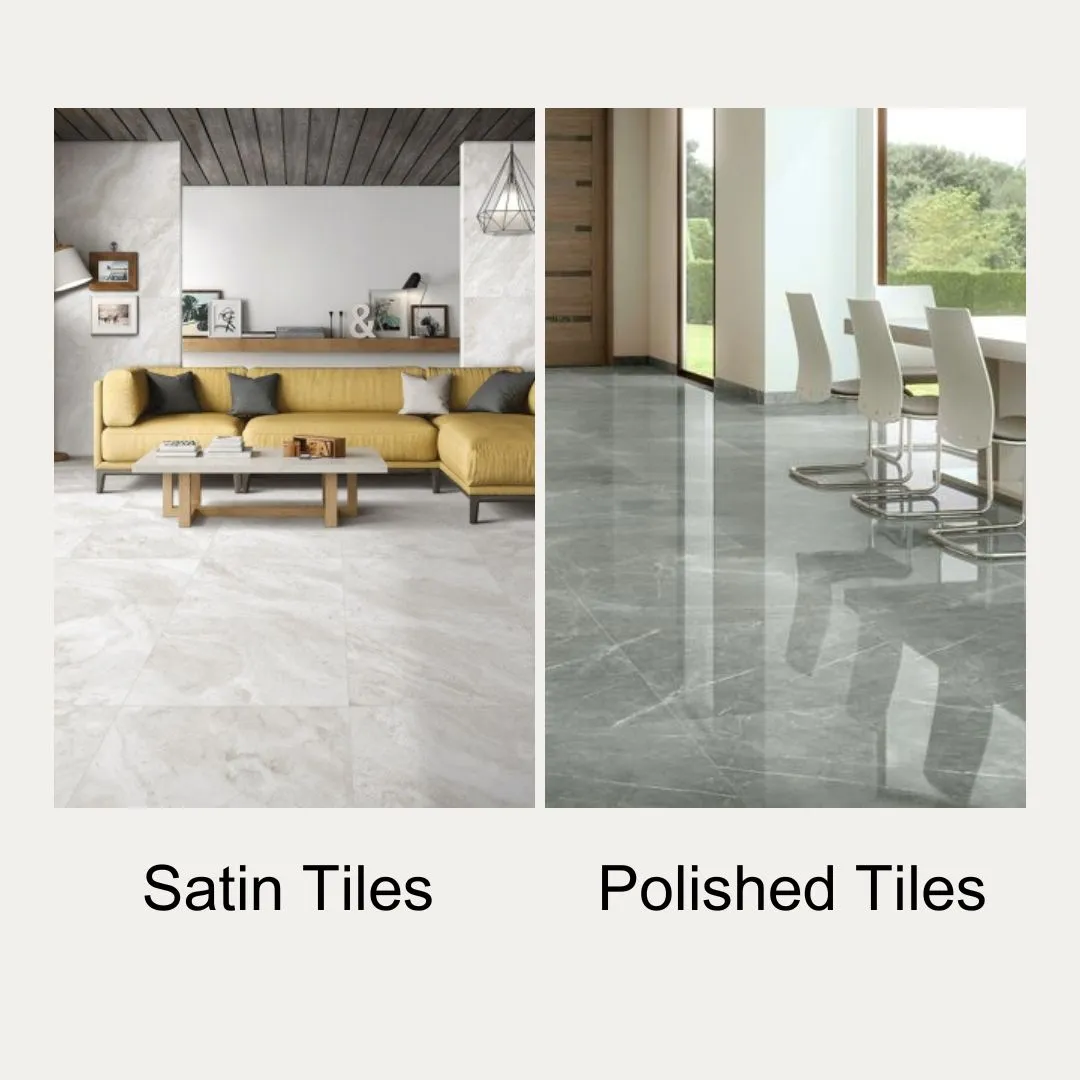Satin vs. Polished Tiles: Unraveling the Differences
06-February-24
Satin vs. Polished Tiles: Unraveling the Differences
Introduction
In the world of interior design, choosing the right type of tile can make a significant difference in the overall look and feel of a space. When it comes to tile finishes, two popular options often come to mind: satin and polished. But what exactly sets these two finishes apart? And which one is the right choice for your project?
In this article, we delve into the nuances of satin and polished tiles to unravel their key differences and help you make an informed decision. From their unique characteristics and appearance to their practicality and maintenance requirements, we leave no stone unturned in our quest to give you a comprehensive understanding of these finishes.
Whether you're looking to revamp your bathroom, kitchen, or any other room in your home, understanding the distinctions between satin and polished tiles is crucial. By the end of this article, you'll be equipped with the knowledge you need to confidently select the perfect tile finish that not only complements your design aesthetic but also stands the test of time.
Shop High Quality Glazed Porcelain Tile
Section 1: Understanding the Differences Between Satin and Polished Tiles
Satin and polished tiles may appear similar at first glance, but upon closer inspection, their differences become apparent. Satin tiles have a soft, smooth, and matte finish, while polished tiles have a reflective, glossy surface that imparts a luxurious feel to any space. These distinctions in appearance stem from the manufacturing process and the materials used
Satin tiles are typically made by applying a satin glaze to the surface of the tile and firing it at a lower temperature. This glaze creates a velvety texture that is pleasing to the touch and gives satin tiles a subtle, understated elegance.
On the other hand, polished tiles undergo an additional step after firing, where the surface is mechanically polished to achieve a mirror-like finish. This polishing process enhances the natural shine of the tile, making it a popular choice for those seeking a sleek and sophisticated look.
Aside from their appearance, satin and polished tiles also differ in terms of their slip resistance. Satin tiles offer a higher level of traction due to their slightly textured surface, making them a safer choice for areas prone to water or moisture, such as bathrooms and kitchens. Polished tiles, on the other hand, can be more slippery when wet, so they are better suited for dry areas like living rooms or bedrooms.
Section 2: Pros and Cons of Satin Tiles
Satin tiles offer several advantages that make them a compelling choice for many homeowners. One of the key benefits of satin tiles is their ability to conceal dirt, dust, and smudges, thanks to their matte finish. This makes satin tiles an excellent option for high-traffic areas or homes with children and pets, as they require less frequent cleaning and maintenance.
Another advantage of satin tiles is their versatility. The soft and understated appearance of satin tiles allows them to blend effortlessly with various design styles, from contemporary to rustic. Satin tiles are available in a wide range of colors and patterns, making it easy to find the perfect match for your desired aesthetic.
However, satin tiles also have a few drawbacks to consider. Due to their matte finish, satin tiles may show scratches more easily compared to their polished counterparts. Additionally, satin tiles are generally less reflective, which means they may not be the best choice if you're looking to maximize the light and brightness in a room.
In terms of maintenance, satin tiles are relatively easy to clean. Regular sweeping and occasional mopping with a mild detergent are usually sufficient to keep them looking their best. However, it's essential to avoid using abrasive cleaners or tools that could damage the satin finish.
Section 3: Pros and Cons of Polished Tiles
Polished tiles offer a distinct set of advantages that make them a popular choice among homeowners who crave a touch of elegance and sophistication. The glossy surface of polished tiles reflects light, creating an illusion of space and adding a luxurious feel to any room. This makes polished tiles an excellent option for smaller spaces or areas that lack natural light.
Another advantage of polished tiles is their durability. The polishing process not only enhances the appearance but also strengthens the surface of the tile, making it more resistant to scratches and wear. This durability makes polished tiles ideal for high-traffic areas or homes with active families.
While polished tiles boast a range of benefits, they also come with a few considerations. The reflective nature of polished tiles means they are more prone to showing dirt, footprints, and smudges. Regular cleaning and maintenance are necessary to keep them looking pristine. Additionally, the glossy surface of polished tiles can be more slippery when wet, so caution should be exercised in areas where water or moisture is present.
Maintaining polished tiles requires regular sweeping or vacuuming to remove dust and debris. A damp mop with a mild, non-abrasive cleaner can be used for deeper cleaning. It's essential to avoid using acidic or abrasive cleaning products that could dull or damage the polished surface.
Section 4: Debunking Myths About Slippery Satin Tiles
One common misconception about satin tiles is that they are slippery. While it's true that satin tiles may not offer the same level of slip resistance as their textured counterparts, they are not inherently slippery. The slipperiness of a tile surface depends on various factors, including the texture, slope, and presence of water or other substances.
To enhance the slip resistance of satin tiles, there are several measures that can be taken. Applying an anti-slip treatment to the surface of the tiles can significantly improve traction. Additionally, using rugs or mats in areas where slipperiness is a concern can provide an extra layer of safety. It's important to note that these precautions can be applied to any type of tile, not just satin.
Ultimately, the slipperiness of a tile should be evaluated on a case-by-case basis, considering the specific area where it will be installed and the intended use. Consulting with a professional or tile expert can help determine the best tile choice for your specific needs.
Section 5: Factors to Consider When Choosing Between Satin and Polished Tiles
When deciding between satin and polished tiles, several factors should be taken into account. The first consideration is the intended use of the space. Satin tiles are generally preferred for areas that are prone to water or moisture, such as bathrooms, kitchens, or outdoor spaces, due to their higher slip resistance. Polished tiles, on the other hand, are better suited for dry areas like living rooms, bedrooms, or hallways.
Another factor to consider is the overall design aesthetic you wish to achieve. Satin tiles lend themselves well to various styles, from contemporary to traditional, thanks to their subtle and versatile appearance. Polished tiles, with their glossy and reflective surface, are often chosen for more modern and luxurious designs.
The lighting in the room should also be taken into consideration. Polished tiles can help maximize the natural light in a space, making it appear brighter and more open. This can be particularly beneficial in rooms with limited windows or natural light sources. Satin tiles, on the other hand, may be a better choice for rooms that already receive ample natural light or have a softer, more subdued lighting scheme.
Budget is another crucial factor when making a decision between satin and polished tiles. Generally, polished tiles tend to be more expensive due to the additional steps involved in the manufacturing process. Satin tiles, with their simpler finish, are often more budget-friendly while still offering an elegant and timeless look.
Section 6: Tips for Maintaining Satin and Polished Tiles
Regardless of whether you choose satin or polished tiles, proper maintenance is essential to ensure they retain their beauty and durability over time. Here are some tips for keeping your tiles in top condition:
-> Regularly sweep or vacuum the floor to remove dirt, dust, and debris. This will prevent scratches and maintain the overall cleanliness of the tiles.
-> Use a damp mop with a mild detergent to clean the tiles. Avoid using abrasive or acidic cleaners, as they can damage the surface.
-> Wipe up spills or stains immediately to prevent them from penetrating the tiles
-> Place doormats or rugs in high-traffic areas to minimize the amount of dirt and debris that comes into contact with the tiles.
-> Avoid dragging heavy furniture or objects across the tiles, as this can cause scratches or chips.
-> Consider applying a sealant or protective coating to enhance the longevity and stain resistance of the tiles. Consult with a professional to determine the most suitable product for your specific tile type.
By following these simple maintenance tips, you can ensure that your satin or polished tiles remain in pristine condition for years to come, maintaining the beauty and value of your space.
Section 7: Satin vs. Polished Tiles: Which is Better for Different Areas of the Home?
The choice between satin and polished tiles ultimately depends on the specific area of the home. Here are some recommendations for where each finish thrives:
-> Bathrooms and Kitchens: Due to their higher slip resistance, satin tiles are an excellent choice for bathroom and kitchen floors or walls. The soft and matte finish of satin tiles also complements the clean and functional aesthetics often found in these areas.
-> Living Rooms and Bedrooms: Polished tiles can add a touch of elegance and sophistication to living rooms and bedrooms, where slip resistance is not as critical. The reflective surface of polished tiles can help create a sense of spaciousness and enhance the overall ambiance of these relaxation areas.
-> Hallways and Entryways: Both satin and polished tiles can work well in hallways and entryways, depending on the desired look and practicality. Satin tiles can help mask dirt and footprints, making them a practical choice for high-traffic areas. Polished tiles, on the other hand, can make a bold statement and set the tone for the rest of the home.
-> Outdoor Spaces: When it comes to outdoor areas, satin tiles are often the preferred choice due to their higher slip resistance and ability to withstand exposure to the elements. Satin tiles with a textured surface can provide additional traction, ensuring safety even in wet or rainy conditions.
Remember that these recommendations are not set in stone, and personal preferences and design goals should ultimately guide your decision. It's important to consider the specific needs and requirements of each area when selecting the appropriate tile finish.
Section 8: Popular Finishes for Satin and Polished Tiles
Satin and polished tiles come in a variety of finishes, allowing you to customize the look and feel of your space. Here are some popular finishes for each type of tile:
Satin Tiles:
- Matte : A classic and timeless finish that offers a soft and velvety texture.
- Glazed : Adds a subtle sheen to the tiles, enhancing their visual appeal.
- Textured : Provides additional slip resistance and depth to the tiles, making them ideal for wet areas.
Polished Tiles:
- High Gloss: The most reflective and mirror-like finish, creating a luxurious and glamorous atmosphere.
- Semi-polished : Strikes a balance between matte and high gloss, offering a more subdued shine.
- Honed : A matte finish with a slight sheen, perfect for those seeking a more understated elegance.
These finishes can be combined and mixed to create unique patterns and designs, allowing you to truly personalize your space and make a statement with your tile selection.
Conclusion: Making an Informed Decision for Your Tile Selection
Choosing between satin and polished tiles may seem overwhelming at first, but with a clear understanding of their differences and considerations, you can make an informed decision that aligns with your design goals and practical needs.
Satin tiles offer a soft and matte finish, ideal for areas that require slip resistance and easy maintenance. They are versatile and blend well with various design styles, making them a popular choice for bathrooms and kitchens.
Polished tiles, on the other hand, boast a glossy and reflective surface that adds a touch of elegance and sophistication to any space. They are durable and ideal for dry areas like living rooms and bedrooms, where slip-resistance is not a primary concern.
By carefully evaluating factors such as the intended use of the space, design aesthetic, lighting conditions, and budget, you can select the perfect tile finish that not only enhances the beauty of your home but also stands the test of time.
Remember to properly maintain your satin or polished tiles through regular cleaning and care to ensure they continue to impress for years. With the right knowledge and attention, your tile selection will transform your space into a gleaming masterpiece.












